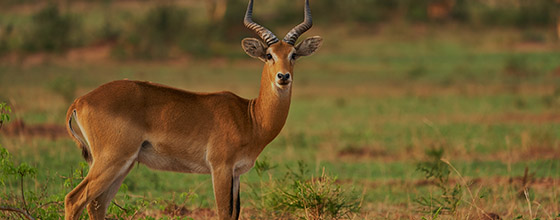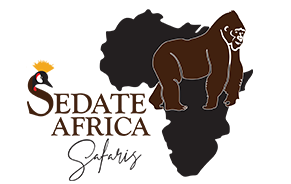
Murchison Falls Aka World’s Most Powerful Falls
The 3,840km2 Murchison Falls National Park is one of Uganda’s oldest protected areas. Originally gazetted as the Bunyoro and Gulu Wildlife Reserve in 1926, it was upgraded to form one of Uganda’s first national parks in 1952. The 5072km2 expanse of Murchison Falls NP and the contiguous Karuma and Bugungu Wildlife Reserves are managed collectively as the Murchison Falls Conservation Area. At Murchison Falls, the Nile explodes through an 6m wide gorge and plunges 45m into the ‘Devil’s Cauldron.’ The boat trip along the Nile to Murchison Falls is one of East Africa’s top wildlife spectacles.
The northern section of the park contains savanna and borassus palms, acacia trees and riverine woodland. The south is dominated by bush and forest. Murchison Falls National Park lies at the northern end of the Albertine Rift Valley where the sweeping Bunyoro escarpment merges into a vast, palm-dotted savannah. First gazetted as a game reserve in 1926 it is Uganda’s largest and oldest conservation area, hosting 76 species of mammals and over 451 birds. The park is bisected by the Victoria Nile which races west through the park for 80km, descending a series of rapids before exploding through a narrow (6m) gap in the remnant rift valley cliffs. This 45m plunge drains the last of the river’s energy transforming the torrent into a broad, placid stream that flows quietly across the rift valley floor towards Lake Albert.
The river below the fall provides one of Uganda’s finest wildlife spectacles. Regular visitors to the riverbank include elephants, giraffes and buffaloes while hippos, Nile crocodiles and aquatic birds are permanent residents. The 1951 film “The African Queen” starring Humphrey Bogart was filmed on Lake Albert and the Nile below Murchison Falls. Other notable visitors to the park include Winston Churchill, Theodore Roosevelt, Ernest Hemingway and several British royals.
Access Roads
A number of routes can be used to reach the Nile at Paraa, the parks’ main tourism hub. The river is crossed using a ferry that runs at intervals throughout the day. Southern Entrance Gates Two routes lead to Paraa lead from Masindi town, which is 305km from Kampala (a 4 hour drive). The most direct is the 86km approach which enters the park through Kichumbanyobo Gate, 16km from Masindi. Diversions along the way include the Kaniyo Pabidi section of Budongo Forest, the Heart of Murchison game viewing area and Murchison Falls. A longer but more scenic alternative route from Masindi runs to Paraa via Bulisa (136km). The route passes through Budongo Forest before a memorable descent of the rift valley escarpment with views across Lake Albert towards the Blue Mountains of the Democratic Republic of Congo. The park can be entered through Bugungu or Mubako gate. The latter is convenient for visitors staying in the cluster of lodges just outside the park’s western boundary.
Northern Entrance Gates Murchison Falls National Park can also be reached on the north side of the Nile via the Chobe, Wankwar and Tangi gates. These are all accessed from the Kampala-Pakwach road which crosses the Nile at Karuma Falls in the northeastern corner of the park, 260kms from Kampala. These gates are convenient for visitors travelling to/from Gulu town and Kidepo Valley National Park. AIR Pakuba Airfield, 19km from North Paraa, can be reached using chartered aircraft from Entebbe International Airport or Kajjansi airfield near Kampala. Other airfields in the park include Chobe to the east and Bugungu to the south of Paraa.
Climate
During the day, the temperature is around 25-32oC, making this one of the hottest regions in Uganda. Nights are cooler, dropping to around 18oC. Rainfall is low, though when it arrives it falls in torrential storms.
When to Visit
The best time to visit is during the dry seasons from December to late February and from June to September when animals are concentrated around water points. The prime time for bird watching is January-March when tourist numbers are lowest.
Accommodation
A range of privately operated accommodation facilities in and around the park caters for up-market, medium range and budget visitors. UWA operates a campsite and a students’ centre dormitory style with 60 beds at North Paraa. Camping is also possible at the Top of the falls. Other concessionaires include Chobe Safari Lodge, which is undoubtedly the gem in Uganda’s crown of tourism destinations. Offers breathtaking panoramic views, coupled with the sounds of the River Nile’s magnificent rapids, sets the scene for an adventure that will impress even the most discerning of visitors Paraa Safari Lodge; Gives you the unforgettable experience and memories of Uganda’s hospitality Pakuba Safari Lodge; Strategically located along the River Nile offering breathtaking views and spectacular scenery that enhances an excellent wild experience. Red Chilli Rest Camp; Offers affordable accommodation in the heart of Murchison Falls National Park Sambiya River lodge; not just a place to sleep, but a great African wilderness experience.
Outside the Park
Ziwa Rhino Sanctuary
The 70km2 Ziwa Rhino Sanctuary is home to Uganda’s only wild rhinos. Track them on foot and support this important step towards the eventual reintroduction of rhinos to protected areas. Ziwa lies close to the Kampala-Gulu road, 5km before the turning to Masindi. Visit www.rhinofund.org for more information.
Park activities should be booked and paid for at UWA Headquarters in Kampala or at the Kibale NP Office at Isunga. Bookings, but not payment, can also be made at the Kibale Conservation Area Office in Fort Portal (see contacts at end).
PRIMATE WALK (CHIMPANZEE TRACKING)
The perennially popular primate walk provides the chance to observe chimpanzees in their natural habitat. Kanyanchu’s groups are accustomed to human presence – some have been observed for over 25 years – and the chance of locating them is over 90%. Walks leave Kanyanchu Visitor Centre at 08.00, 11.00 and 14.00 and last between 2-5 hours. Early arrival to allow for registration and briefing is recommended. Contact time with chimpanzees is limited to one hour; group size is limited to six visitors; participants must be aged 16 or over. Advance booking is essential.
CHIMPANZEE HABITUATION EXPERIENCE
The Chimpanzee Habituation Experience (CHEX) enables visitors to accompany researchers and habituators into the forest. The chimpanzee groups involved are less accustomed to human presence than those visited on the Primate Walk and following and viewing them is both exciting and challenging. The CHEX sessions is available on a full or half day basis starting at 0630. Advance booking for this activity is required.
NATURE WALKS
A Nature Walk is an opportunity to enjoy one of East Africa’s most beautiful and varied forests without pressure to locate chimpanzees or tick off a dozen ‘Kibale specials’ on the birdlist. This is also an ideal activity for young visitors unable to accompany relatives on the Primate Walk. Two hour Nature Walks begin at 08.00, 10.00 and 14.00 from Kanyanchu Tourist Centre.
NIGHT WALKS
Enter the forest after dark to search for nocturnal creatures such as galagos, pottos and bushbabies. Night walks are conducted from 19.30-22.00 daily.
BIRDING
A birdlist of 372 forest, grassland and swamp species, including local endemics and Central Africa ‘specials’ makes Kibale a popular destination for birders. Forest birds can be sought, with the help of experienced UWA guides, on the forest trails at Kanyanchu and Sebitoli tourism sites. This experience should be combined with a visit to Bigodi Wetland Sanctuary to add forest edge and swamp specials to the list. This popular, communityrun attraction lies just outside the park, 5km south of Kanyanchu.
